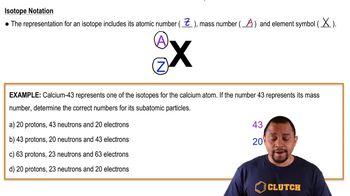Complete and balance the following nuclear equations by supplying the missing particle: (a) 147N + 42He¡? + 11H
Ch.21 - Nuclear Chemistry

Brown15th EditionChemistry: The Central ScienceISBN: 9780137542970Not the one you use?Change textbook
Chapter 21, Problem 31
Write balanced equations for (a) 238922U + 1n -> 224194Pu. (b) 147N + 1a -> 1p + 178O. (c) 5626Fe + 1a -> 1b + 6029Cu.
 Verified step by step guidance
Verified step by step guidance1
Step 1: Identify the type of nuclear reaction for each equation. For example, determine if it is a fission, fusion, or decay process.
Step 2: For each equation, ensure that the sum of atomic numbers (subscripts) and mass numbers (superscripts) are equal on both sides of the equation. This is based on the law of conservation of mass and charge.
Step 3: For equation (a), balance the equation by adding the appropriate particles (such as neutrons or protons) to ensure both sides have equal atomic and mass numbers.
Step 4: For equation (b), balance the equation by identifying the missing particle (1a) and ensuring the atomic and mass numbers are balanced on both sides.
Step 5: For equation (c), determine the identity of the missing particle (1b) by balancing the atomic and mass numbers, ensuring the equation is balanced.
Key Concepts
Here are the essential concepts you must grasp in order to answer the question correctly.
Nuclear Reactions
Nuclear reactions involve changes in an atom's nucleus and can result in the transformation of one element into another. They typically include the emission or absorption of particles such as neutrons (n), alpha particles (α), and beta particles (β). Understanding the types of nuclear reactions is essential for balancing equations, as it helps identify the reactants and products involved.
Recommended video:
Guided course

Nuclear Binding Energy
Balancing Nuclear Equations
Balancing nuclear equations requires ensuring that both the mass number and atomic number are conserved during the reaction. This means that the sum of the mass numbers and the sum of the atomic numbers on the reactant side must equal those on the product side. Mastery of this concept is crucial for accurately writing and interpreting nuclear equations.
Recommended video:
Guided course

Balancing Chemical Equations
Isotopes and Atomic Notation
Isotopes are variants of a particular chemical element that have the same number of protons but different numbers of neutrons, resulting in different mass numbers. Atomic notation, which includes the element symbol, mass number, and atomic number, is used to represent isotopes. Familiarity with isotopes and their notation is vital for correctly identifying and writing nuclear reactions.
Recommended video:
Guided course

Isotope Notation Example
Related Practice
Textbook Question
Textbook Question
Complete and balance the following nuclear equations by supplying the missing particle: (d) 5826Fe + 2 10n¡6027Co + ?
Textbook Question
Complete and balance the following nuclear equations by supplying the missing particle: (e) 23592U + 10n¡13554Xe + 2 10n + ?
Textbook Question
Some watch dials are coated with a phosphor, like ZnS, and a polymer in which some of the 1H atoms have been replaced by 3H atoms, tritium. The phosphor emits light when struck by the beta particle from the tritium decay, causing the dials to glow in the dark. The half-life of tritium is 12.3 yr. If the light given off is assumed to be directly proportional to the amount of tritium, by how much will a dial be dimmed in a watch that is 50 yr old?
1
views
